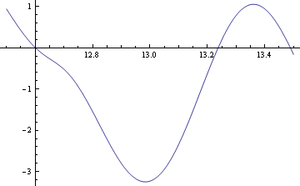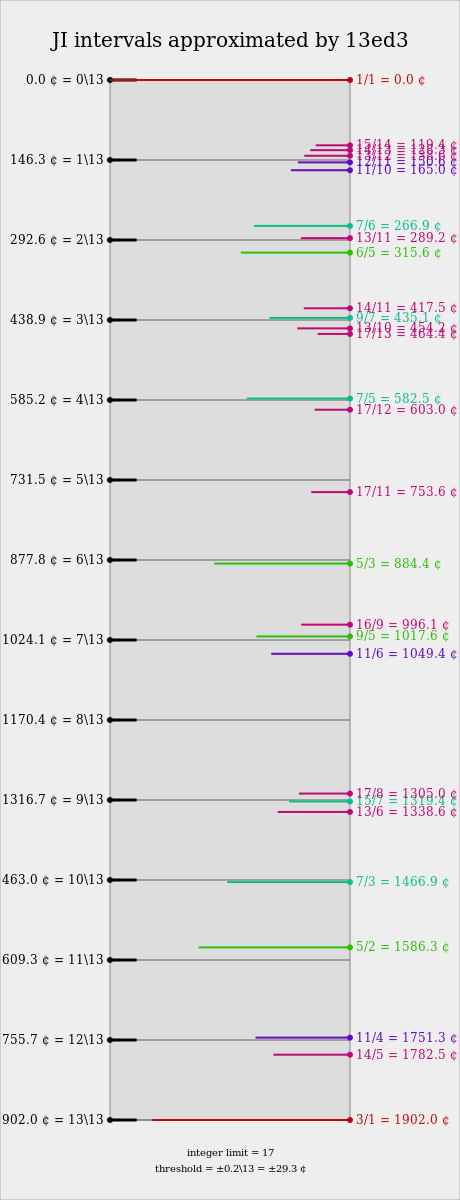13edt
| ← 12edt | 13edt | 14edt → |

13 equal divisions of the tritave (13edt) is the nonoctave tuning system derived by dividing the tritave (3/1) into 13 equal steps of 146.3 cents each, or the thirteenth root of 3. It is best known as the equal-tempered version of the Bohlen–Pierce scale, and therefore has received by far the most attention among equal divisions of the tritave.
It provides an excellent approximation to the 3.5.7 subgroup, especially for its size, being comparable to 34edo's accuracy in the 5-limit. In this subgroup, it tempers out 245/243 and 3125/3087, the same commas as bohpier temperament. It is less impressive in higher prime limits, but makes for excellent no-twos 7-limit harmony. For higher limits, the multiples of 13 (26edt, 39edt, and 52edt) come to the fore.
13edt can be described as approximately 8.202edo. This implies that each step of 13edt can be approximated by 5 steps of 41edo.
In the no-2 3/1-equave-7-limit, 13edt maintains the smallest relative error of any EDT until 258edt and 271edt, and the smallest absolute error until 56edt.
Theory
| Harmonic | 3 | 5 | 7 | 9 | 11 | 13 | 15 | 17 | 19 | 21 | 23 | |
|---|---|---|---|---|---|---|---|---|---|---|---|---|
| Error | Absolute (¢) | +0.00 | -6.53 | -3.83 | +0.00 | -54.80 | -51.40 | -6.53 | +69.39 | +23.14 | -3.83 | -15.02 |
| Relative (%) | +0.0 | -4.5 | -2.6 | +0.0 | -37.5 | -35.1 | -4.5 | +47.4 | +15.8 | -2.6 | -10.3 | |
| Steps (reduced) |
13 (0) |
19 (6) |
23 (10) |
26 (0) |
28 (2) |
30 (4) |
32 (6) |
34 (8) |
35 (9) |
36 (10) |
37 (11) | |
| Harmonic | 25 | 27 | 29 | 31 | 33 | 35 | 37 | 39 | 41 | 43 | 45 | |
|---|---|---|---|---|---|---|---|---|---|---|---|---|
| Error | Absolute (¢) | -13.07 | +0.00 | +22.59 | +53.44 | -54.80 | -10.36 | +39.74 | -51.40 | +8.32 | +72.17 | -6.53 |
| Relative (%) | -8.9 | +0.0 | +15.4 | +36.5 | -37.5 | -7.1 | +27.2 | -35.1 | +5.7 | +49.3 | -4.5 | |
| Steps (reduced) |
38 (12) |
39 (0) |
40 (1) |
41 (2) |
41 (2) |
42 (3) |
43 (4) |
43 (4) |
44 (5) |
45 (6) |
45 (6) | |
Intervals
| Steps | Cents | Hekts | Enneatonic degree |
Corresponding 3.5.7 subgroup intervals |
Lambda (sLsLsLsLs, E = 1/1) |
|---|---|---|---|---|---|
| 0 | 0 | 0 | P1 | 1/1 | E |
| 1 | 146.3 | 100 | A1/m2 | 49/45 (−1.1 ¢); 27/25 (+13.1 ¢) | F |
| 2 | 292.6 | 200 | M2/d3 | 25/21 (−9.2 ¢) | F#, Gb |
| 3 | 438.9 | 300 | A2/P3/d4 | 9/7 (+3.8 ¢) | G |
| 4 | 585.2 | 400 | A3/m4/d5 | 7/5 (+2.7 ¢) | H |
| 5 | 731.5 | 500 | M4/m5 | 75/49 (−5.4 ¢) | H#, Jb |
| 6 | 877.8 | 600 | A4/M5 | 5/3 (−6.5 ¢) | J |
| 7 | 1024.1 | 700 | A5/m6/d7 | 9/5 (+6.5 ¢) | A |
| 8 | 1170.4 | 800 | M6/m7 | 49/25 (+5.4 ¢) | A#, Bb |
| 9 | 1316.7 | 900 | A6/M7/d8 | 15/7 (−2.7 ¢) | B |
| 10 | 1463.0 | 1000 | P8/d9 | 7/3 (−3.8 ¢) | C |
| 11 | 1609.3 | 1100 | A8/m9 | 63/25 (+9.2 ¢) | C#, Db |
| 12 | 1755.7 | 1200 | M9/d10 | 135/49 (+1.1 ¢); 25/9 (−13.1 ¢) | D |
| 13 | 1902.0 | 1300 | A9/P10 | 3/1 | E |
JI approximation
Regular temperament properties
| Subgroup | Comma list | Mapping | Optimal Equave stretch (¢) |
Tuning error | |
|---|---|---|---|---|---|
| Absolute (¢) | Relative (%) | ||||
| 3.5.7 | 245/243, 3125/3087 | [⟨13 19 23]] (b13) | +1.393 | 1.150 | 0.79 |
Rank-2 temperaments
| Periods per tritave |
Generator (reduced) |
Cents (reduced) |
Associated ratio |
Temperament |
|---|---|---|---|---|
| 1 | 1\13 | 146.30 | 49/45 | Procyon |
| 1 | 2\13 | 292.61 | 25/21 | Sirius |
| 1 | 3\13 | 438.91 | 9/7 | BPS |
| 1 | 4\13 | 585.22 | 7/5 | Canopus |
| 1 | 5\13 | 731.63 | 75/49 | |
| 1 | 6\13 | 877.83 | 5/3 | Arcturus |
See also
- Bohlen-p_et
- Catalog of 3.5.7 subgroup rank two temperaments
- No-twos subgroup temperaments#3.5.7 subgroup temperaments
- 19ED5: relative ED5
- 23ED7: relative ED7
